Square Enix loves to remaster and remake their games, which only makes sense given their beloved back catalogue. Sometimes, these re-releases are well-received, like Legend of Mana or the Final Fantasy pixel remasters. Other times, they are more maligned, like Final Fantasy VIII Remastered, or worse, the old Final Fantasy V and Final Fantasy VI mobile and PC ports. As the next remaster on their slate, Chrono Cross: The Radical Dreamers Edition invites many questions about where it falls in the remaster hierarchy. To answer in brief, it isn’t the most ambitious of remasters, and it certainly has some issues, but it is still a perfectly viable (and more importantly, available) version of one of my personal greatest games.
Chrono Cross was originally released in 1999 in Japan (2000 in North America) and came as the sequel to one of the most revered games of all time, Chrono Trigger. As a bold follow-up to veritable gaming royalty, Chrono Cross was destined to become a divisive title. While Chrono Trigger was a project by the “dream team” of Dragon Quest’s Yuji Horii, Final Fantasy’s Hironobu Sakaguchi, and Dragon Ball’s Akira Toriyama, Chrono Cross was instead helmed by Masato Kato. Kato was an essential figure in Chrono Trigger’s development, but one largely unknown to fans. Not only that, many fans felt Chrono Trigger wrapped up perfectly, leaving little room for a sequel. Chrono Cross had a solution: alternate dimensions.
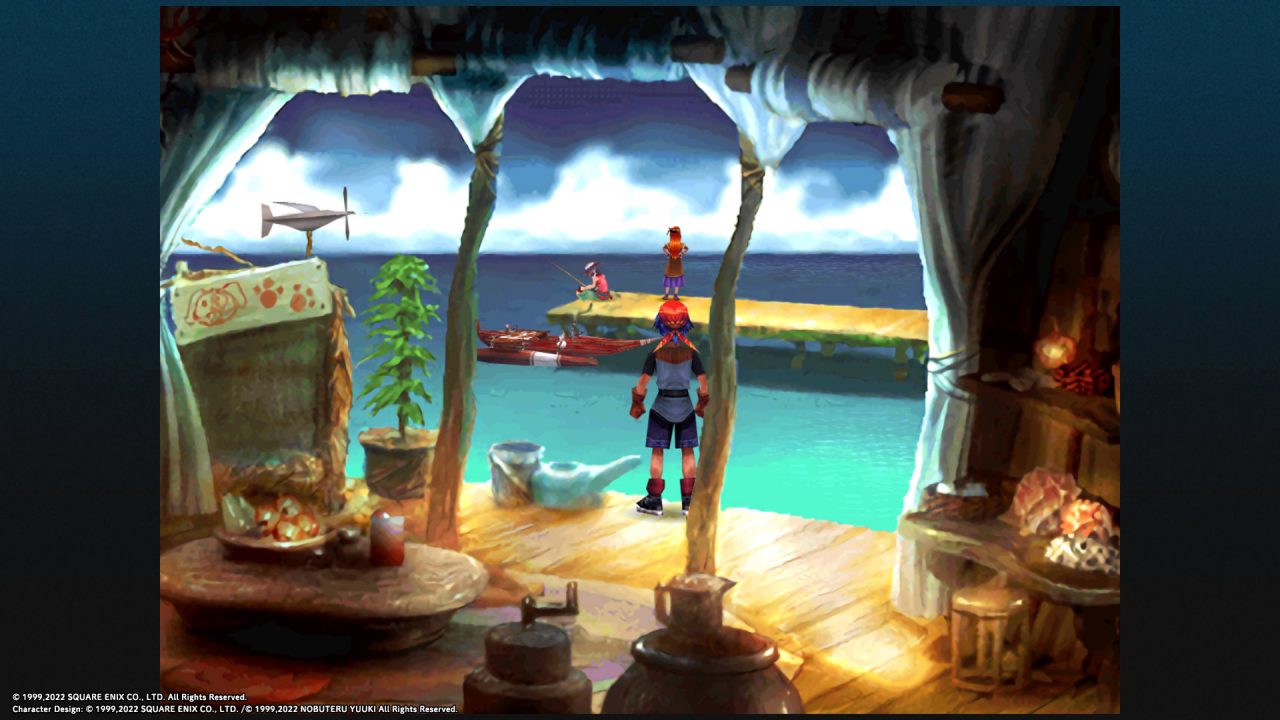
Chrono Cross begins with a young man named Serge gathering scales to create a necklace for his childhood friend (and possibly more), Leena. However, the pleasant evening on the beach that follows is interrupted: a voice calls out to Serge, visions flash through his mind, and he faints. He comes to, still on the beach but alone. Something is wrong. His hometown is decidedly off. The mayor is a different man, someone else lives in the house he shares with his mother (who is nowhere to be found), and Leena doesn’t even recognize him. He has been transported to Another World.
At first, Serge sets out with his new friend, the bold and sassy Kid, to find a way home and maybe answer the mysteries of this strange world along the way. It isn’t long, however, before he finds himself fighting for the fate of the worlds. It is a JRPG, after all.
Like many JRPGs of its time, Chrono Cross has a world map to wander and multiple modes of transport. Instead of an entire world, Chrono Cross spotlights the densely packed El Nido archipelago, an endlessly imaginative place that begs to be explored. Beautiful locales—from sleepy seaside villages to mysterious ancient ruins—await. Groups of humans, dwarves, faeries, and demi-humans grapple physically and politically to find and keep homes among the islands and waves. Great dragons once worshiped by the people of El Nido slumber, awaiting a plucky adventurer like yourself.
Serge can also travel back to his home dimension, giving you access to two versions of El Nido. In one world, you may find a thriving village or manor in place of a desolate ruin in the other. A verdant swamp populated by dwarves may greet you in your home dimension, while it is a terrible, acidic place in the other world. Whatever side of the dimensional split you’re traversing, chats with NPCs allow you to glean a tremendous amount of lore. Seeking this lore can clarify mysteries around the story and characters as well as their relationship to Chrono Trigger.
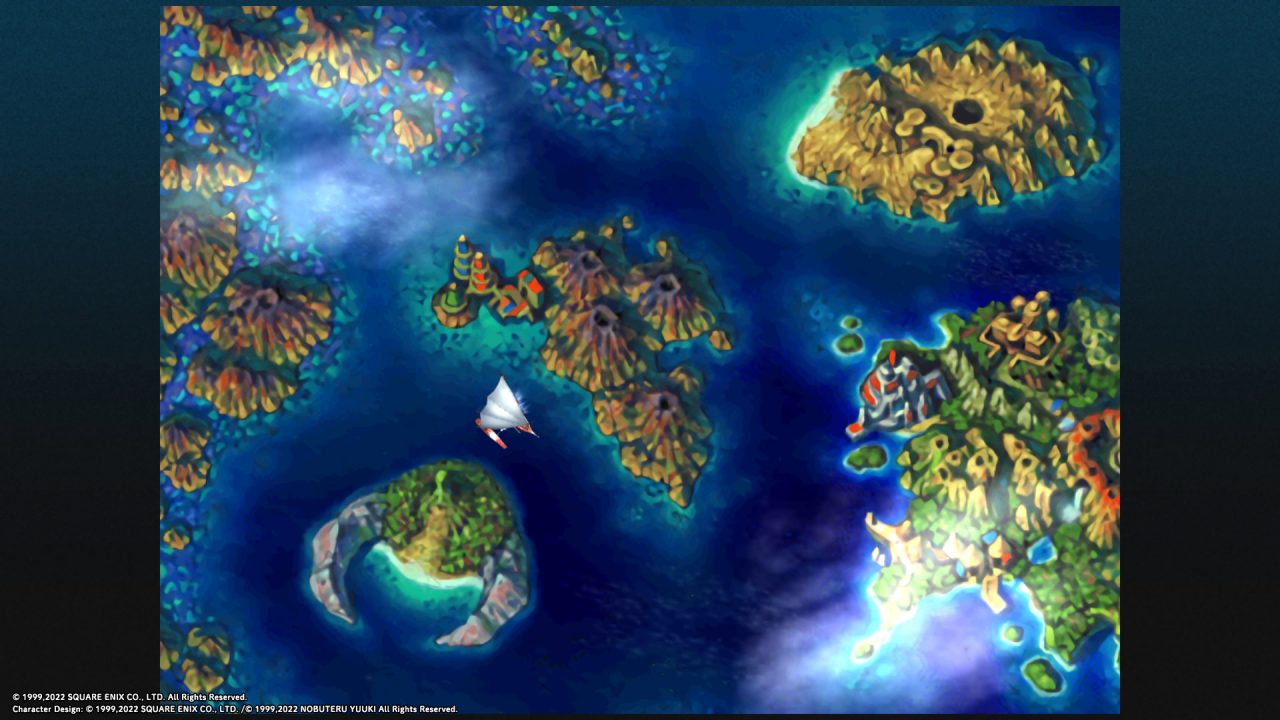
One mechanic that ties nicely into the world-building is that weapons and armour are crafted or found, not bought. This allows for an organic progression of equipment upgrades that doesn’t feel forced, unlike many other JRPGs with a series of town shops and increasing prices. Instead, you get new weapons and armour because you braved dangerous places and obtained materials the blacksmiths didn’t have access to before. For example, there is a shortage of iron at the beginning of the game, explaining the inventory restricted to copper equipment.
Like other Squaresoft titles from the era, Chrono Cross has a customization system akin to Final Fantasy VII’s materia, Final Fantasy VIII’s junctioning, or Final Fantasy IX’s abilities. Elements are items you buy, find, steal, and receive from defeated enemies. They can be equipped to a character’s element grid (which grows as you progress through the game), then used in battle to cast spells, recover HP, and even summon powerful creatures. Most elements are one-use-per-battle, but some are consumable. Up to five of these can be equipped to one grid slot, allowing for multiple uses. Of course, it isn’t just as simple as equipping your strongest elements and then blowing through every battle; you have to build up your element levels while managing your stamina gauge to use them.
Regular attacks in Chrono Cross come in three levels from weakest to strongest. The weakest attack only costs one stamina and has a higher probability, of hitting, while the strongest attack costs three stamina and has a low chance of hitting — at first. When you land a hit, the chances of hitting for the rest of that character’s combo increase, allowing you to use the stronger attacks more confidently. Each attack that hits also builds the element level of the character by one, two, or three, which allows them to cast higher tier elements equipped to their element grid. So, a weak, medium, and then strong attack will cost six stamina. If they all hit, increase the character’s element level by six. You could then spend that to cast a single level-six element or any other appropriate combination. Once a character’s stamina is spent (or even thrown into the negatives by casting an element), you can switch to another character and take their actions. Each action from another character or enemy in battle allows the stamina of the target character to restore. Since you can switch characters at any time and enemy actions can come between your actions, battles have a steady flow that makes them feel almost real-time.
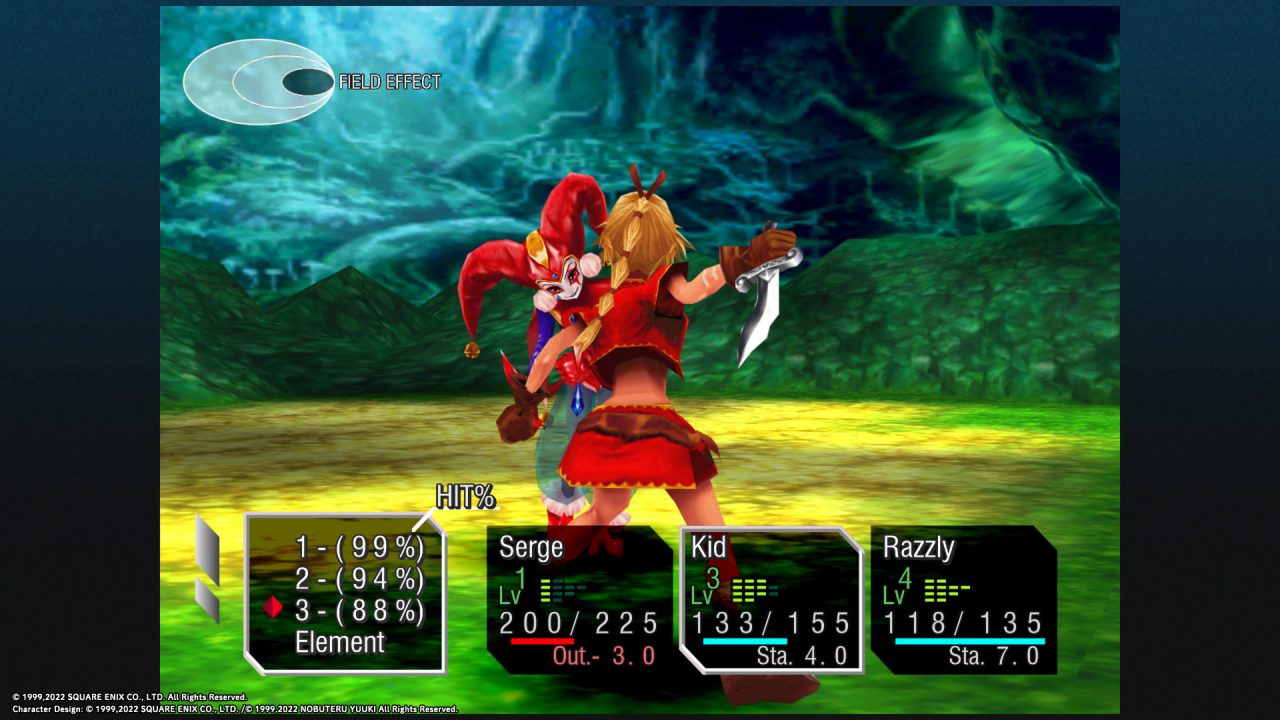
Finally, elements are also impacted by the field effect. The top left corner of the screen shows current elemental properties of the battlefield with a three-segment grid. Every time an element is used, the left segment is pushed off the field and the newest element takes over the far-right segment. This matters because elements are stronger when the field matches their colour, and weaker with an opposite field. Summons can only be cast with a field effect entirely of their colour. For example, the red summon Salamander can only be cast when all three segments are red. These mechanics create an enjoyable balancing act that enemies can throw awry at any moment. While Chrono Cross is not a particularly difficult game, it can be a lot of fun trying to fight battles how you want to fight them, and not how the enemy wants you to.
To supplement its unique battle system, Chrono Cross also has a character progression system that is innovative to this day. Instead of gaining experience towards a new level, your party gains a “star level”’ when they beat a boss. These star levels influence the stats and element grids of every character you have available. The currently active party members also receive small, permanent boosts to their stats (most commonly HP) by winning regular battles. These stat boosts are finite for each character from each monster type, so you can grind them out if you want, but star levels alone keep characters up to speed and the bonus stats are the cherry on top.
Nobuteru Yūki’s sometimes wild and always wonderful character designs complement the gorgeous world of Chrono Cross that Yasuyuki Honne’s pre-rendered backgrounds bring to life. Players are certainly not starved for choice of characters, either. Forty-five different characters can join in all, though not everyone can be obtained in a single playthrough. These characters accompany you for a various reasons: perhaps you assemble the scattered bones of an undead skeleton, and he decides to tag along on your quest, or maybe a mysterious magician agrees to be your guide for a daring break-in. Some characters are mandatory, but many are optional and even missed depending on your investigation and choices.
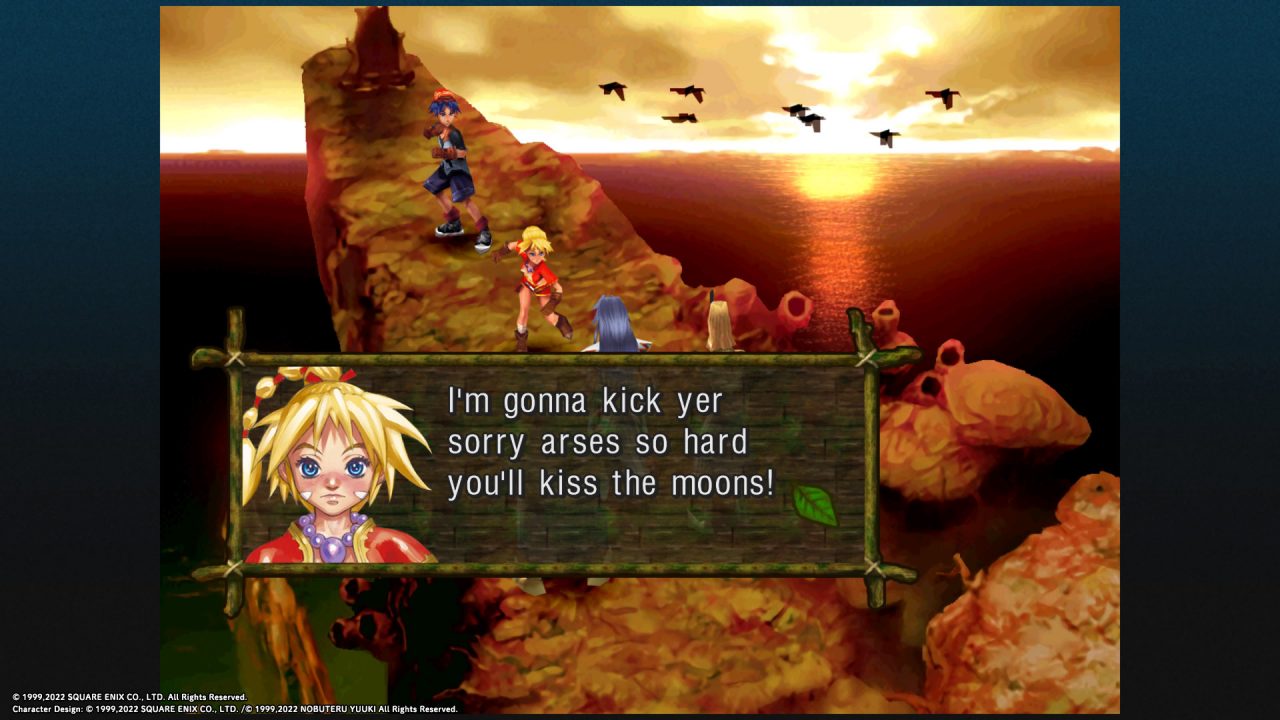
The number of playable characters does mean a lack of screen time for many of them. Even when they do speak during the main story, their dialogue is exactly interchangeable with other characters. This lack of unique dialogue is improved by a very cool accent generation algorithm that manages to give each character a unique voice. Each character does have a place in the world, and they may even have optional side quests that grant them more depth along with their most potent techs (special character-specific elements) or special weapons. There is also something inherently joyful in choosing your party from a cast of oddballs. Want to fight the final boss with Starky the Martian and Leah the super-strong jungle-child at your side? You can. I have to admit, however, that obtaining certain characters, techs, or scenes can be needlessly obtuse. Some may enjoy the sense of discovery from things like rejecting a character three times who it is clearly fitting to accept or purposefully leaving a character behind who is linked to the current story, but it can also be punishing.
Chrono Cross has some neat quality of life features to manage its large cast, too. You can easily remove all accessories or elements from a character, and there are options to auto-fill the element grid of an individual character or even the entire party. Another cool quality of life perk is that you are offered the chance to heal after every battle and can even choose whether or not to use consumables to do so.
Yasunori Mitsuda is a widely celebrated composer, and for good reason. The man has repeatedly created some of the greatest soundtracks in the industry, from Chrono Trigger to Xenoblade Chronicles 2. I hold Chrono Cross not just as his best work, but my favourite soundtrack of any game. The world music influences and variety of sounds are truly breathtaking. It has a song to fit every occasion within the story, including two equally incredible overworld themes for the two parallel dimensions. Strangely, the recently announced newly-arranged songs are nowhere to be found in game. Instead, some of them play on the launcher where you choose between Chrono Cross and Radical Dreamers, or you can purchase the album. Of course, since the original soundtrack is so wonderful, this doesn’t bother me. However, the miscommunication around the use of these tracks could be frustrating for some.
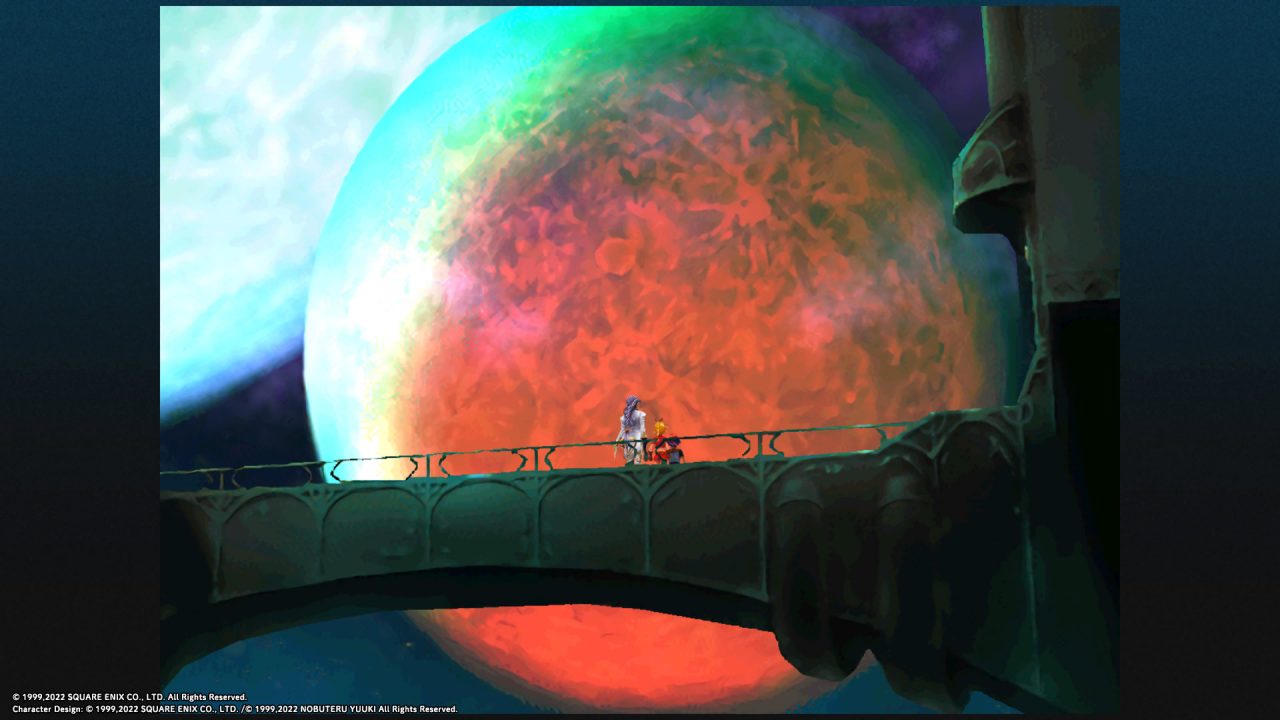
Chrono Cross is often ponderous, even meditative. It asks questions, lots of them: of choice and consequence, of self and identity, of the morality of existence and finding your place. It provides answers, even conflicting answers, to several of these questions, but also encourages the player to draw their own conclusions. I have seen Chrono Cross called pretentious or convoluted, but I disagree. There is a very real and very human purpose to Chrono Cross’s twists and turns that sometimes feel drowned out by the discourse around its existence as a sequel to Chrono Trigger. In many ways, playing Chrono Cross feels like sitting down for a personal, philosophical conversation with the director and his team. It’s a message about life and it is meant to be contemplated by you and me.
I’ve written a lot about Chrono Cross the game, but what about Chrono Cross the remaster? Unfortunately, this remaster is likely to come as a disappointment to many. It lacks new features, has audio distortion in some of the sound effects, the FMVs are in the original resolution (consequently looking awful in 4k), and the unstable framerate of the original might even be worse now. The visual options are also subpar. You can only choose between new or classic graphics. New has HD models, a very strong smoothing filter, and an updated font, while classic is just the original game. I played the new option because I wanted to see the HD models. I didn’t regret it, but the smoothing filter is… a lot, and I prefer the pixelated font of the original.
There are some silver linings, though. The ability to increase the game’s speed at any time is always a nice feature and even helps mitigate some of the framerate issues. Avoiding enemy encounters is great when you realize you missed something and backtrack for the third time where you can no longer gain stat boosts from enemies. My favourite change is the new editing pass on the system text. This means item and element names are updated and corrected to modern standards. For example, there is an element in the original game called PhysNegate which is now called Negate Physical. The odd lack of spacing in element names from the original has been removed as well, which I prefer. You also get access to Radical Dreamers outside of Japan for the first time, which is a neat visual novel that is a sort of alternate universe interquel to Chrono Trigger and Chrono Cross and deserves a review of its own.
Chrono Cross is not just a personal favourite, but also a deeply personal game, and I have many emotional ties to it. Having the opportunity to play it on modern consoles, even in a flawed form, is a tremendous boon. I hope this remaster will satisfy other fans and bring in new fans that might not have had the chance to play it before.



